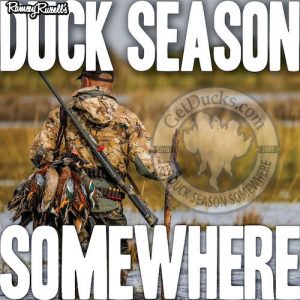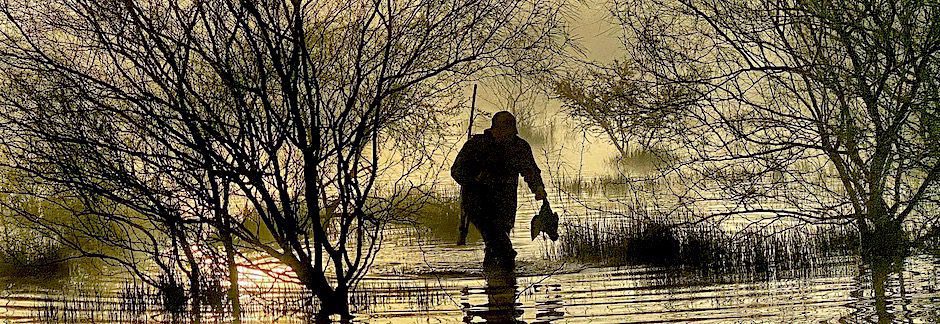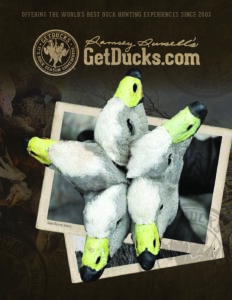MOJO’S Duck Season Somewhere Podcast
EP 542. They Really Hunt Coots in Louisiana?! And Much More

Roland Cortez talks about being born and raised duck hunting in South Louisiana’s marshes, his earliest influences and introductions, how and why he’s been guiding duck hunts for a very long time, and even why coots–yes coots–are among his favorite game birds as tablefare. We talk about then versus now, raising young hunters, prevalent species hunted, favored hunting techniques, hopes for the season remainder and future, and much more. Ramsey even adds “attend coot round up with Roland Cortez” to his bucket list!
EP 541. Wild Goose Jack Miner Goes Mainstream

Jack Miner Bible-verse-inscribed leg bands have long been revered as holy grail momentos among in-the-know waterfowl hunters. Formed in 1904 by a former fur trapper and market hunter, the Jack Miner Migratory Bird Sanctuary once garnered international attention and was Canada’s foremost tourist attraction, connecting legions of both hunters and non-hunters to wild geese and ducks. But times change. Public interests shift. Now in a time where habitat loss is unprecedented, where hunter participation increasingly dwindles, and a more urbanized humanity is disengaged from their wild surroundings, Jack Miner’s legacy seems more important than ever before. Collaborating with 50 Ducks’ streaming migration technology, they’re on an “education is conservation” mission to turn the tide. And need your help. Tune in to learn more about Jack Miner’s past, present and future and how you can join them meaningfully in renewed waterfowl conservation efforts.
*****
Related Info:
Millions of people in North America are unaware of the critical challenges facing waterfowl and the ecosystems they rely on. With wetlands disappearing at an alarming rate, how can we inspire more people to join the conservation cause? That’s why we created 50 Ducks—in partnership with the Jack Miner Foundation—a pioneering platform that allows you to follow waterfowl in near real-time using GPS telemetry data. By sharing their incredible migration journeys, 50 Ducks connects people to the beauty of these birds and their habitats, fostering a deeper appreciation and driving support for conservation efforts.
From classrooms naming their own waterfowl to hunters and birders exploring near real-time migration data, 50 Ducks brings the “sky to screen,” fostering a deep connection to wildlife and wetlands. With over 1,350 historical birds and dozens of live birds you can follow today—and more added to the map every fall and spring—you can track the movements of waterfowl across North America. It all starts at Jack Miner, but the sky’s the limit for where we can go. Help us help birds by joining today!
Join the movement today and help protect our wetlands! Visit https://50ducks.com/signup/ and use the code GETDUCKS for 10% off your subscription. After signing up, download the app for even more features! Together with Jack Miner, and nonprofits across the continent we aim to educate the next generation of conservationists.
EP 540. The Chesapeake Bay Legends

Saying that museums tell stories, Chesapeake Bay historian and preservationist, C. John Sullivan, takes us on a personal tour of one of the largest private collections amassed, where each artifact represents one of the most storied time periods in American waterfowling history. After a brief visit–where I actually shouldered a 22-pound, 4-gauge, side-by-side blackpowder shotgun–we talk about giant guns, specialized hunting tools, market hunter techniques, wooden decoys, famous carvers, and a completely bygone, but not yet forgotten, way of life on the fabled Chesapeake Bay.
EP 539. West Virginia Duck Hunt

“Almost Heaven, West Virginia, Blue Ridge Mountains, Shenandoah River,” go the John Denver lyrics. The iconic song never mentions ducks or duck hunting. For good reason. Because they’re few and far between, but not impossible. State 48 was a huge, successful adventure thanks to friend Mike Smith. Following a couple eventful days duck hunting West Virginia, we crack open a couple Busch Lights, recall the weeks events, talk about his growing up and duck hunting in this off-the-beaten-flyway part of Appalachia.
EP 537. Prince Edward Island Duck Hunting

This season’s 6-province Canadian part if the tour terminates 8 miles into the Atlantic–as easterly as personally ever been in North America–on the picturesque Prince Edward Island where my host, Geoff “Woody” Wood welcomes me with fresh Malpeque oysters and kicks things off with as traditional island-style decoys as it gets. Following a couple days memorable black duck hunts and eats, and with a nor’easter blowing outside, we talk about Prince Edward Island duck hunting, species, techniques, food, habitat changes and more.
EP 536. Powered by Inukshuk–And Here’s Why

Our beloved retrievers are our ride-and-die best friends, but they’re also high-performing athletes with singular life missions to recover downed birds regardless of weather conditions. They deserve the very best nutrition. With an if-you-know-you-know, almost cult-like following among serious US retriever circles, Inukshuk Professional Dog Food is sold directly to consumers and has no ambitions of being widely distributed in big-box retailers. Raised into the business, company president Emily Corey describes Inukshuk Professional Dog Food’s humble origins, explaining how and for what purposes their highly digestible, calorie-dense formulas are derived, why Inukshuk is the highest quality dog food available, how their direct-to-consumer model ensures superior freshness, and why a “corporate culture” that keeps them in close, personal contact with customers is win-win-win.
Related Links:
InukShuk Professional Dog Food
EP 535. New Brunswick Canada Duck Hunting, Eh?

A month-and-a-half and 11-plus-thousand miles after starting this year’s North American Waterfowl Road Trip finally arrives to new territory, to the land-time-forgot (so described for reasons discussed herein) province of New Brunswick, Canada. Joining local go-getter hunters Matt Wilson and Stephen Margison, am immersed neck-deep into Maritime Canada waterfowl hunting culture where distances are described relative to time, where directions are described relative to the St. Johns River, and where daily agendas are relative to Canada geese, black ducks and mallards. It’s here that was inspired to conform my chicken-fried recipe to local standard (recipe shared). “Canada duck hunting” may not have evoked thoughts of New Brunswick in the past, but you better believe it will moving forward! Bet that you’ll agree, eh?
EP 534. Moonshine Creek, NB

Breaking a streak of mishaps, happening by accident onto Moonshine Creek Distillery was pure luck. It was maybe even some kind of divine providence. “Well, I’ve been making it legally for about 6 years,” says Jeremiah Brooks in giving us the full run down, explaining how he went from tending bars and improving his understanding of spirits to creating the Canada Whiskey of the Year—plus a bar-top-full assortment of unique flavors reflecting real New Brunswick–just a few short years later. More than a tasty deep-dive into various spirits, the conversation provides an interesting view of Maritime Canada and it’s historically blurred-boundary relationship with the US that’s located down winding roads a short distance away. Bottoms up!
EP 533. Here Comes Santa Clause–Into the Vault

Just in time for Christmas–because few if any of us are leaving the blind to elbow our way through crowded shopping malls–Duck Unlimited’s David Schuessler takes us Into the Vault, where this year’s offerings are bigger and better than ever. Whether trying to find something for that someone’s that’s hard to shop for, or shopping for yourself, here’s your extraordinary chance to claim rare and exclusive treasures, from unique, one-of-a-kind firearms to remarkable prints and never-before-seen relics. Bidding opened November 27–go check it out now. And best of all–you’re giving back to the ducks, too!
EP 532. Mississippi Duck Season Opener Traditions

Back home for the Mississippi duck season opener, Ramsey meets his 2 favorite hunting buddies, sons Forrest and Duncan. Duck season opener at camp a decades-old tradition. Recalling past times and people, they discuss the day’s events and plot the season’s remainder.








